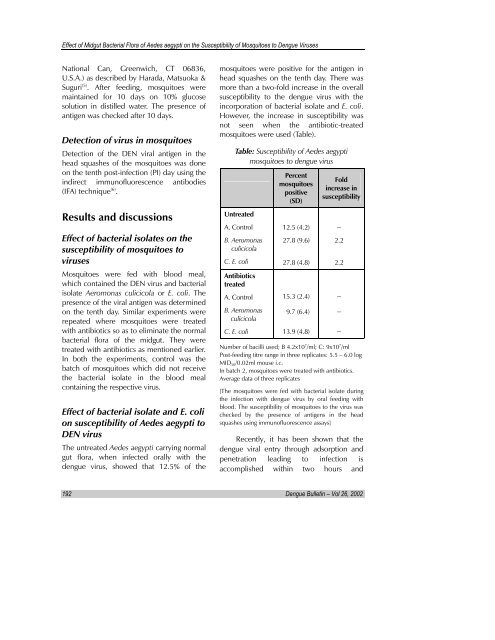Dengue Bulletin
Dengue Bulletin
Dengue Bulletin
- TAGS
- dengue
- bulletin
- 203.90.70.117
Create successful ePaper yourself
Turn your PDF publications into a flip-book with our unique Google optimized e-Paper software.
Effect of Midgut Bacterial Flora of Aedes aegypti on the Susceptibility of Mosquitoes to <strong>Dengue</strong> Viruses<br />
National Can, Greenwich, CT 06836,<br />
U.S.A.) as described by Harada, Matsuoka &<br />
Suguri (5) . After feeding, mosquitoes were<br />
maintained for 10 days on 10% glucose<br />
solution in distilled water. The presence of<br />
antigen was checked after 10 days.<br />
Detection of virus in mosquitoes<br />
Detection of the DEN viral antigen in the<br />
head squashes of the mosquitoes was done<br />
on the tenth post-infection (PI) day using the<br />
indirect immunofluorescence antibodies<br />
(IFA) technique (6) .<br />
Results and discussions<br />
Effect of bacterial isolates on the<br />
susceptibility of mosquitoes to<br />
viruses<br />
Mosquitoes were fed with blood meal,<br />
which contained the DEN virus and bacterial<br />
isolate Aeromonas culicicola or E. coli. The<br />
presence of the viral antigen was determined<br />
on the tenth day. Similar experiments were<br />
repeated where mosquitoes were treated<br />
with antibiotics so as to eliminate the normal<br />
bacterial flora of the midgut. They were<br />
treated with antibiotics as mentioned earlier.<br />
In both the experiments, control was the<br />
batch of mosquitoes which did not receive<br />
the bacterial isolate in the blood meal<br />
containing the respective virus.<br />
Effect of bacterial isolate and E. coli<br />
on susceptibility of Aedes aegypti to<br />
DEN virus<br />
The untreated Aedes aegypti carrying normal<br />
gut flora, when infected orally with the<br />
dengue virus, showed that 12.5% of the<br />
mosquitoes were positive for the antigen in<br />
head squashes on the tenth day. There was<br />
more than a two-fold increase in the overall<br />
susceptibility to the dengue virus with the<br />
incorporation of bacterial isolate and E. coli.<br />
However, the increase in susceptibility was<br />
not seen when the antibiotic-treated<br />
mosquitoes were used (Table).<br />
Table: Susceptibility of Aedes aegypti<br />
mosquitoes to dengue virus<br />
Untreated<br />
A. Control<br />
B. Aeromonas<br />
culicicola<br />
C. E. coli<br />
Antibiotics<br />
treated<br />
A. Control<br />
B. Aeromonas<br />
culicicola<br />
C. E. coli<br />
Percent<br />
mosquitoes<br />
positive<br />
(SD)<br />
12.5 (4.2)<br />
27.8 (9.6)<br />
27.8 (4.8)<br />
15.3 (2.4)<br />
9.7 (6.4)<br />
13.9 (4.8)<br />
Fold<br />
increase in<br />
susceptibility<br />
192 <strong>Dengue</strong> <strong>Bulletin</strong> – Vol 26, 2002<br />
−<br />
2.2<br />
2.2<br />
Number of bacilli used; B 4.2x10 7 /ml; C: 9x10 7 /ml<br />
Post-feeding titre range in three replicates: 5.5 – 6.0 log<br />
MID 50/0.02ml mouse i.c.<br />
In batch 2, mosquitoes were treated with antibiotics.<br />
Average data of three replicates<br />
[The mosquitoes were fed with bacterial isolate during<br />
the infection with dengue virus by oral feeding with<br />
blood. The susceptibility of mosquitoes to the virus was<br />
checked by the presence of antigens in the head<br />
squashes using immunofluorescence assays]<br />
Recently, it has been shown that the<br />
dengue viral entry through adsorption and<br />
penetration leading to infection is<br />
accomplished within two hours and<br />
−<br />
−<br />
−









